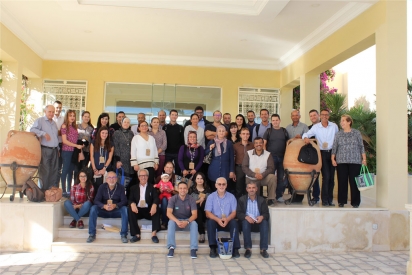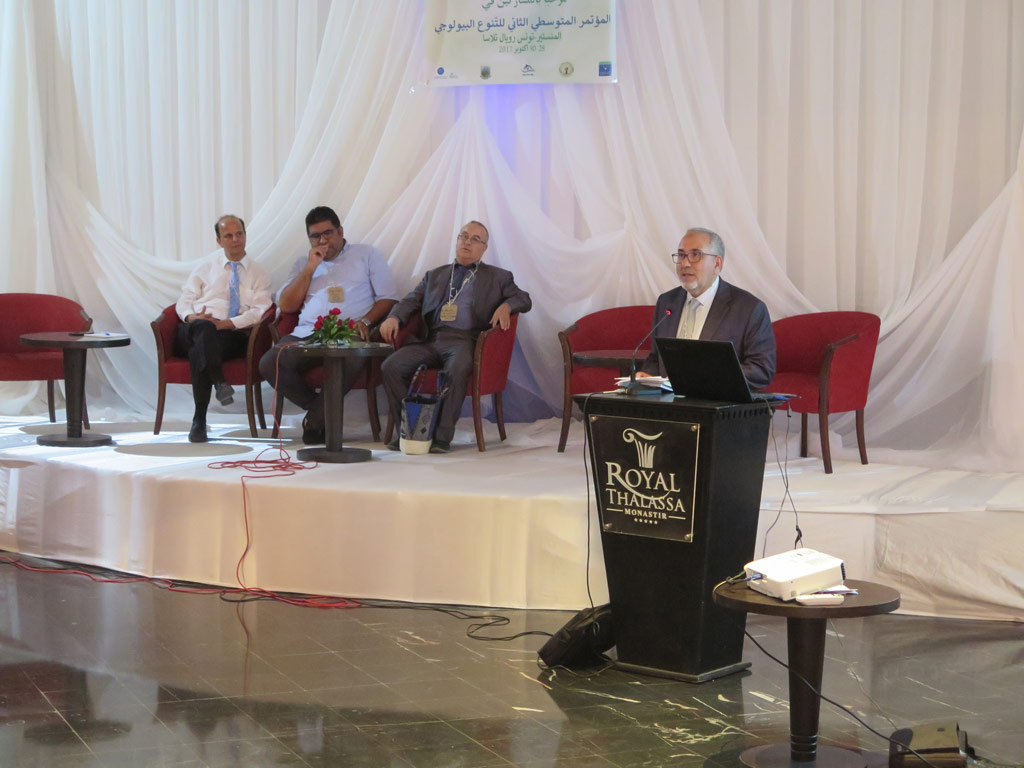Search
11/17: A look back at the Biodiv 2017 Conference
ASCOB-Syrtis organized in collaboration with SPA/RAC the "BIODIV 2017" conference from 28 to 30 October 2017 in Monastir, Tunisia
The association for biodiversity conservation in the Gulf of Gabes (ASCOB-Syrtis) organized in collaboration with SPA/RAC, the second edition of the Conference on biodiversity "Biodiv", from 28 to 30 October 2017 in Monastir, Tunisia. The theme of the conference was "Biodiversity: directions for research and conservation tools".
For this event, SPA/RAC held two conferences. The first one, entitled "Barcelona Convention and Non-Indigenous Species", was presented by Atef Ouerghi and Yassine Ramzi Sghaier during the session "Invasive species and climate change".
Opening of the conference, with Mohamed Ali Ben
Temessek (Representative of the Tunisian Ministry of
Local Affairs and Environment),
Atef Ouerghi (Program officer, SPA/RAC),
Hechmi Missaoui (INSTM Director),
Mohamed Nejmeddine Bradai (President of ASCOB-
Syrtis).
Species introductions in the Mediterranean, a core topic and an important environmental issue in the region, sparked a lively debate. According to the most recent scientific studies, more than 6% of marine species in the Mediterranean are considered non-native species. The number of introduced species recorded up to now exceeds 1,000 species, and this number is increasing at a rate of one new record every 2 weeks (cf. communication of Atef Ouerghi and Yassine Ramzi Sghaier).
Tunisia is not spared the species introductions phenomenon. One of the most remarkable species is the blue crab, P. segnis. Since 2014, year of its first sight, this crab has become very abundant, invading the entire Gulf of Gabes. The species is voracious and prolific. In the Gulf of Gabes, this species is landed by different fishing gear, where its hourly output far exceeds 100 kg / h (for more information, see communication of Olfa Ben Abdallah Ben Hadj Hamida & Nader Ben Hadj Hamida).
Setting up a monitoring program is a necessity to control and mitigate the impacts of species introduction. Tunisia is one of the seven Mediterranean countries that have benefited in recent months from SPA/RAC support within the framework of the implementation of IMAP of the Barcelona Convention, to develop a national monitoring program for biodiversity and non-indigenous species (for more information, see the EcAp-MED II project webpage).
The exchange of information is also a priority. As such, the MAMIAS database remains an important platform to collect and share surveillance data on introduced species.
The second conference organized by SPA/RAC focused on Marine Protected Areas (MPAs) in the Mediterranean, the opportunities and challenges and was presented by Souha El Asmi during the session "Protected species / areas".
This conference highlighted the latest progress made in terms of protection of marine and coastal areas in the Mediterranean. Important progress has been achieved in setting-up new MPAs and other Other Effective Area-Based Conservation Measures (OECMs). Thus, between 1970 and 2010, there were 40 declarations, while between 2010 and 2016, there were 549. But an additional effort should be made in terms of management plans implementation and MPAs financing (for more details, please read the communication of Souha El Asmi and The 2016 status of Marine Protected Areas in the Mediterranean, main findings).
Finally, Lobna Ben Nakhla, SPA/RAC, presented the Action Plan for the conservation of cartilaginous fishes (chondrichthyans) in the Mediterranean Sea during the session "Resource Management, Conservation and Monitoring of Biodiversity".
This action plan proposes measures to be considered in regional and national strategies to protect sharks and rays, which are particularly threatened by bycatch (see communication of Samira Enajjar et al). Thereupon, a study conducted in the Gulf of Gabes showed that elasmobranchs accounted for more than 50% of total catches in grouper fisheries (see communication of Bashir Saidi et al).
All of these communications and other ones are available online. To view the abstract book, click here.







Find Us On...